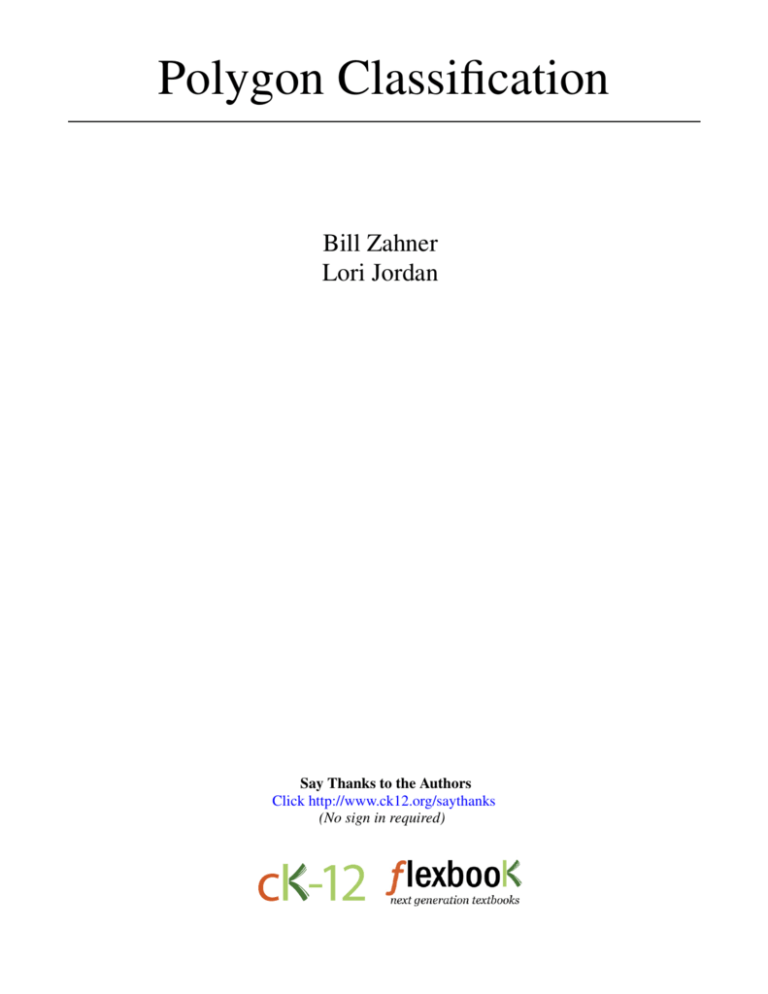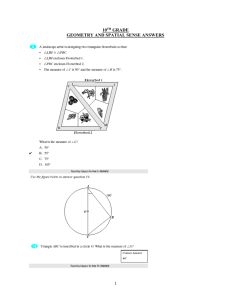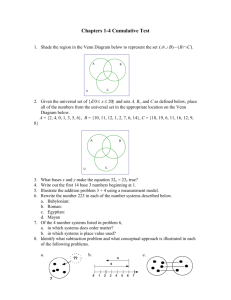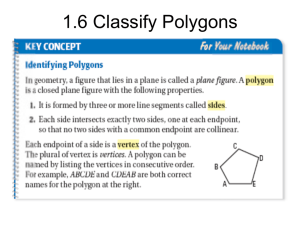Polygon Classification
advertisement

Polygon Classification Bill Zahner Lori Jordan Say Thanks to the Authors Click http://www.ck12.org/saythanks (No sign in required) To access a customizable version of this book, as well as other interactive content, visit www.ck12.org CK-12 Foundation is a non-profit organization with a mission to reduce the cost of textbook materials for the K-12 market both in the U.S. and worldwide. Using an open-source, collaborative, and web-based compilation model, CK-12 pioneers and promotes the creation and distribution of high-quality, adaptive online textbooks that can be mixed, modified and printed (i.e., the FlexBook® textbooks). Copyright © 2015 CK-12 Foundation, www.ck12.org The names “CK-12” and “CK12” and associated logos and the terms “FlexBook®” and “FlexBook Platform®” (collectively “CK-12 Marks”) are trademarks and service marks of CK-12 Foundation and are protected by federal, state, and international laws. Any form of reproduction of this book in any format or medium, in whole or in sections must include the referral attribution link http://www.ck12.org/saythanks (placed in a visible location) in addition to the following terms. Except as otherwise noted, all CK-12 Content (including CK-12 Curriculum Material) is made available to Users in accordance with the Creative Commons Attribution-Non-Commercial 3.0 Unported (CC BY-NC 3.0) License (http://creativecommons.org/ licenses/by-nc/3.0/), as amended and updated by Creative Commons from time to time (the “CC License”), which is incorporated herein by this reference. Complete terms can be found at http://www.ck12.org/about/ terms-of-use. Printed: June 1, 2015 AUTHORS Bill Zahner Lori Jordan www.ck12.org C HAPTER Chapter 1. Polygon Classification 1 Polygon Classification Here you’ll learn how to classify a polygon based on its sides. You’ll also learn how to decide whether a polygon is convex or concave. What if you were told how many sides a polygon has? How would you describe the polygon based on that information? After completing this Concept, you’ll be able to classify a polygon according to the number of sides it has. Watch This MEDIA Click image to the left or use the URL below. URL: http://www.ck12.org/flx/render/embeddedobject/136953 CK-12 Foundation: Chapter1PolygonClassificationA MEDIA Click image to the left or use the URL below. URL: http://www.ck12.org/flx/render/embeddedobject/1282 James Sousa: Classifying Polygons Guidance A polygon is any closed planar figure that is made entirely of line segments that intersect at their endpoints. Polygons can have any number of sides and angles, but the sides can never be curved. The segments are called the sides of the polygons, and the points where the segments intersect are called vertices. The easiest way to identify a polygon is to look for a closed figure with no curved sides. Polygons can be either convex or concave. Think of the term concave as referring to a cave, or “caving in”. A concave polygon has a section that “points inward” toward the middle of the shape. All stars are concave polygons. A convex polygon does not share this property. 1 www.ck12.org Diagonals are line segments that connect the vertices of a convex polygon that are not sides. The red lines are all diagonals. This pentagon has 5 diagonals. Whether a polygon is convex or concave, it can always be named by the number of sides. See the chart below. TABLE 1.1: 2 Polygon Name Triangle Number of Sides 3 Number of Diagonals 0 Quadrilateral 4 2 Pentagon 5 5 Convex Example www.ck12.org Chapter 1. Polygon Classification TABLE 1.1: (continued) Polygon Name Hexagon Number of Sides 6 Number of Diagonals 9 Heptagon 7 14 Octagon 8 ? Nonagon 9 ? Decagon 10 ? 11 ? Undecagon hendecagon or Convex Example 3 www.ck12.org TABLE 1.1: (continued) Polygon Name Dodecagon Number of Sides 12 Number of Diagonals ? n−gon n ( where n > 12) ? Convex Example Example A Which of the figures below is a polygon? The easiest way to identify the polygon is to identify which shapes are not polygons. B and C each have at least one curved side, so they cannot be polygons. D has all straight sides, but one of the vertices is not at the endpoint of the adjacent side, so it is not a polygon either. A is the only polygon. Example B Determine if the shapes below are convex or concave. To see if a polygon is concave, look at the polygons and see if any angle “caves in” to the interior of the polygon. The first polygon does not do this, so it is convex. The other two do, so they are concave. You could add here that concave polygons have at least one diagonal outside the figure. 4 www.ck12.org Chapter 1. Polygon Classification Example C Which of the figures below is not a polygon? C is a three-dimensional shape, so it does not lie within one plane, so it is not a polygon. Watch this video for help with the Examples above. MEDIA Click image to the left or use the URL below. URL: http://www.ck12.org/flx/render/embeddedobject/136954 CK-12 Foundation: Chapter1PolygonClassificationB Guided Practice Name the three polygons below by their number of sides and if it is convex or concave. Answers: A. This shape has six sides and concave, so it is a concave hexagon. B. This shape has five sides and is convex, so it is a convex pentagon. C. This shape has ten sides and is convex, so it is a convex decagon. Explore More In problems 1-6, name each polygon in as much detail as possible. 5 www.ck12.org 1. 2. 3. 4. 5. 6. 7. Explain why the following figures are NOT polygons: 6 www.ck12.org 8. 9. 10. 11. 12. Chapter 1. Polygon Classification How many diagonals can you draw from one vertex of a pentagon? Draw a sketch of your answer. How many diagonals can you draw from one vertex of an octagon? Draw a sketch of your answer. How many diagonals can you draw from one vertex of a dodecagon? Use your answers from 8-10 to figure out how many diagonals you can draw from one vertex of an n−gon? Determine the number of total diagonals for an octagon, nonagon, decagon, undecagon, and dodecagon. Do you see a pattern? BONUS: Find the equation of the total number of diagonals for an n−gon. For 13-17, determine if the statement is ALWAYS true, SOMETIMES true, or NEVER true. 13. 14. 15. 16. 17. A polygon must be enclosed. A star is a concave polygon. A quadrilateral is a square. You can draw (n − 1) triangles from one vertex of a polygon. A decagon is a 5-point star. In geometry it is important to know the difference between a sketch, a drawing and a construction. A sketch is usually drawn free-hand and marked with the appropriate congruence markings or labeled with measurement. It may or may not be drawn to scale. A drawing is made using a ruler, protractor or compass and should be made to scale. A construction is made using only a compass and ruler and should be made to scale. For 18-21, draw, sketch or construct the indicated figures. 18. 19. 20. 21. Sketch a convex heptagon with two sides congruent and three angles congruent. Sketch a non-polygon figure. Draw a concave pentagon with exactly two right angles and at least two congruent sides. Draw an equilateral quadrilateral that is NOT a square. 7







